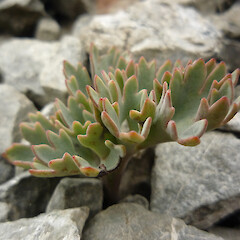Ranunculus haastii
Common name
Haast’s buttercup
Synonyms
Ranunculus haastii Hook.f. subsp. haastii
Family
Ranunculaceae
Flora category
Vascular – Native
Endemic taxon
Yes
Endemic genus
No
Endemic family
No
Structural class
Herbs - Dicotyledons other than Composites
NVS code
The National Vegetation Survey (NVS) Databank is a physical archive and electronic databank containing records of over 94,000 vegetation survey plots - including data from over 19,000 permanent plots. NVS maintains a standard set of species code abbreviations that correspond to standard scientific plant names from the Ngä Tipu o Aotearoa - New Zealand Plants database.
RANHAA
Chromosome number
2n = 48
Current conservation status
The conservation status of all known New Zealand vascular plant taxa at the rank of species and below were reassessed in 2017 using the New Zealand Threat Classification System (NZTCS) – more information about this can be found on the NZTCS website. This report includes a statistical summary and brief notes on changes since 2012 and replaces all previous NZTCS lists for vascular plants.
Please note, threat classifications are often suggested by authors when publications fall between NZTCS assessment periods – an interim threat classification status has not been assessed by the NZTCS panel.
- Conservation status of New Zealand indigenous vascular plants, 2017 . 2018. Peter J. de Lange, Jeremy R. Rolfe, John W. Barkla, Shannel P. Courtney, Paul D. Champion, Leon R. Perrie, Sarah M. Beadel, Kerry A. Ford, Ilse Breitwieser, Ines Schönberger, Rowan Hindmarsh-Walls, Peter B. Heenan and Kate Ladley. Department of Conservation. Source: NZTCS and licensed by DOC for reuse under the Creative Commons Attribution 4.0 International licence.
2017 | At Risk – Declining | Qualifiers: DP, RF
Previous conservation statuses
2012 | At Risk – Declining | Qualifiers: De, DP, EF, RF
2009 | At Risk – Declining | Qualifiers: De, DP, EF, RF
2004 | Not Threatened
Distribution
Endemic. South Island, Eastern side of the main. divided from southern Marlborough south through Canterbury to the Ben Ohau Range.
Habitat
High alpine inhabiting fine-grained shingle-slide screes.
Detailed description
Stout, fleshy, glaucous, summer green perennial herb, 50-150 mm tall, all parts coriaceous; glabrous except for leaf sheath margins. Rhizomes stout, fleshy, 150-200 mm long, often branching, 10-20 mm diam., marked by scars of old leaf bases and vascular strands, oozing viscid and milky latex when damaged; roots stout, 500-800 x 2-5 mm, laterally branching at apices. Achenes glabrous. Body obovate (3.5-)4.0-5.5 mm long; surface dull, pale brown, to dark brown, tinted orange and purple brown, Beak (3.5-)4.0-5.5(-6.5) mm long, curved.
Similar taxa
Distinguished by the mobile scree habit, glaucous, glabrous, deeply incised leaves (with fine hairs present on the leaf sheaths), whose segments are divided 5-7-lobed.
Flowering
September - December
Flower colours
Yellow
Fruiting
November - January
Propagation technique
Difficult. Should not be removed from the wild.
Etymology
ranunculus: From the Latin ‘rana’ frog, meaning little frog and probably refers to the plants typical marshy habit where frogs abound
haastii: Honours the New Zealand geologist and botanist Sir Julius von Haast (1822-87)
Where To Buy
Not commercially available
Attribution
Fact Sheet prepared by P.J. de Lange (12 February 2007). Description based on Fisher (1965).
References and further reading
Fisher, F.J.F. 1965: The alpine Ranunculi of New Zealand. Bulletin, New Zealand Department of Scientific and Industrial Research 165: 1-192.
NZPCN Fact Sheet citation
Please cite as: de Lange, P.J. (Year at time of access): Ranunculus haastii Fact Sheet (content continuously updated). New Zealand Plant Conservation Network. https://www.nzpcn.org.nz/flora/species/ranunculus-haastii/ (Date website was queried)



